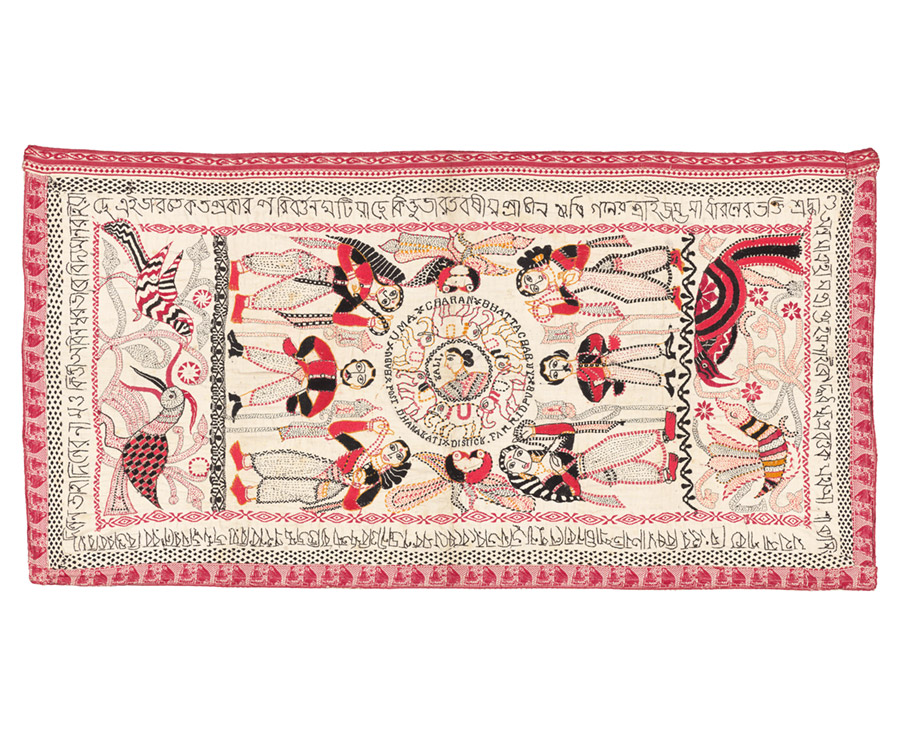Embroidered Dreams: A Personal Appreciation of Bengali Kanthas
- click on the image to enlarge | click on the Expand icon upper left to enlarge further
click Esc to close and return to this page
PLATE 38
Early twentieth century
Cotton plain weave, sari border; hand-sewn and embroidered with cotton thread
40 in. x 21 in. (102 cm x 53 cm)
Mingei International Museum, Gift of Courtenay C. McGowen, 2017-216-001
This pillow cover, or oar, dates to around 1900 and states that it is from Faridpur, East Bengal. It is edged with two types of sari borders, with two inner borders consisting of an imitation of a sari border and a band of writing. Both ends of the oar present beautifully stitched birds. The central mandala is completely surrounded with writing, including the date and the name of the family, presumably the one to which the kantha belonged. Male and female fgures flank the mandala, and the peacocks in between represent Lakshmi, the goddess of wealth.
Notes:
1. The central circle of elephants bears an inscription in English lettering. The enclosed female figure wearing a blouse is identified as “KALI.” The letters going up clockwise from 6 o’clock read, “X BABU X UMA X CHARAN X BHATTACHARUY X.” The letters going counterclockwise also from 6:00 read, “POST.DHANAKATI X DISTICK (sic). FARIDPUR X.”
Comments:
This kantha was presumably made for Uma Charan Bhattacharya, albeit misspelled by the embroiderer. Dhanakati is the name of the town or village where he lived, and the name of the district is Faridpur, also misspelled, now in Bangladesh. It was an important center of kantha production (see Darielle Mason ed. Kantha: The Embroidered Quilts of Bengal [New Haven, Conn. Yale University Press, 2010]). Kali may have been the name of his wife; she perhaps knew some English and fancied herself “European” by wearing Western dress. Bengalis use the word babu (from baba = father) before or after the name of educated men as an honorific.
2. The inscription surrounding the rectangular field of the kantha is in Bengali characters and to my knowledge, it is unique. A literal English translation is as follows:
The names and deeds of all the wise and religious persons who were born in this sacred land of India and enhanced its glory in ancient times are forever preserved. Numerous changes have occurred in this land of India, but there has been no diminution of the admiration and respect for these great souls among the masses of the country. The originator of the Buddhist faith was Mahatma (Great Soul) Shakyasimha.
Comments: The inscriptions make this an unusual example of a kantha. The Bengali panegyric clearly indicates devotion to the Buddha, but, the name in the English inscription—Uma Charan Bhattacharya—is that of a Hindu, and a brahman to boot. It should be noted that, in the adjoining district of Chittagong, east of Faridpur, Buddhism has survived until the present, though precariously. A proper explanation of the two inscriptions will require further study, but the use of literary language and historical sensibility of the composer of the inscription are noteworthy. Could the kantha had been made for presentation to a Buddhist temple or monastery in Chittagong?
In any event, if the characterization of the work in the catalogue (see Plate 30 text) as “an oar, a pillow cover,” is correct, then indeed it would be a giant’s pillow; it could of course be a bed cover. However, the central mandala contains the bust of a lady, identified in English as Kali (the name of the owner’s wife?), in western dress. The space between the central medallion and the border of the English inscription is filled with walking elephants, which may symbolically represent the Buddha, as one encounters in the Buddhist moonstones in Ceylon and in early Indian Buddhist iconography. The mandala is flanked by pairs of peacocks with entwined necks. Curiously also, the figural composition below and above the mandala are of two males, dressed in European attire and flanked by a pair of winged-female angels with garlands. All of them wear European costumes but with Bengali features. They vaguely recall 18th century Portuguese figures rather than contemporary British. At the top and bottom, separated by stylized trees are pair of confronting, imaginary and colorful birds.
